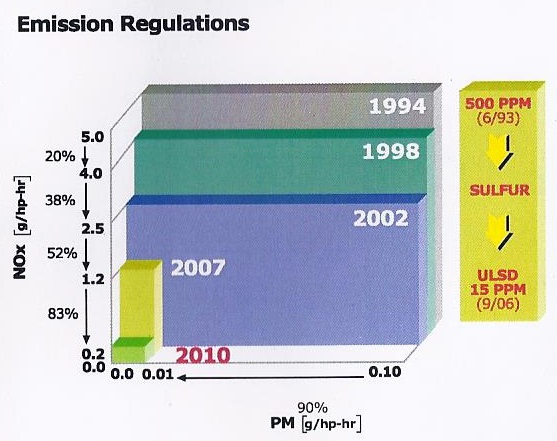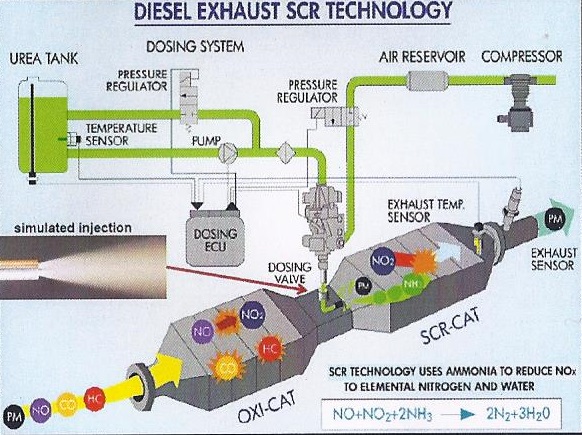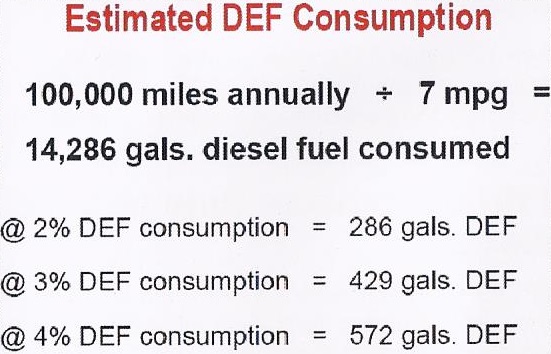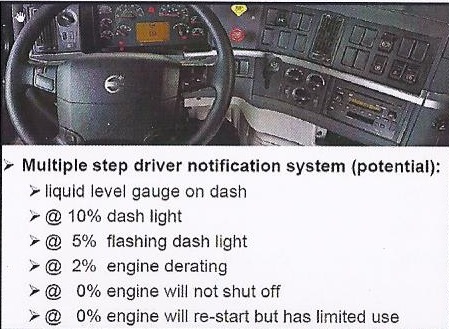
| Information About Diesel Exhaust Fluid Why use SCR / DEF To achieve the nitrogen oxide (NOx) levels required by the EPA 2010 standard, most engine manufacturers are utilizing Selective Catalytic Reduction (SCR) systems that require the addition of Diesel Exhaust Fluid (DEF). Off-road engines will be impacted by similar emission standards beginning in 2014.  What is DEF? DEF is a clear, non-toxic, non-flammable, and non-hazardous organic compound consisting of 32.5% urea and 67.5% de-ionized water that requires no special handling.
The NOx reduction process starts with an engine burning clean Ultra Low Sulfur Diesel and producing exhaust that is already much cleaner do to leaner and more complete combustion. Under the control of the vehicles’ onboard computer, precisely metered spray patters of DEF are injected into the exhaust stream ahead of the SCR converter allowing the exhaust gasses and atomized mist of DEF to enter the converter simultaneously. Together with the catalyst inside the converter, the mixture undergoes a chemical reaction that converts the nitrogen oxides to elemental nitrogen (N2) and water (H2O). Exhaust gases are monitored via a sensor as they leave the SCR catalyst. Feedback is supplied to the main computer that adjusts the DEF flow to keep NOx levels within acceptable parameters.  Is there a chance of mixing DEF with the diesel fuel? It is no likely. While it is possible that the fuel and DEF tanks are located in close proximity, the DEF tank has a smaller opening and a different color cap than the fuel tank to avoid contamination. How will DEF perform in cold weather? DEF is designed to operate in cold climates. The closed system is equipped with temperature controlled tanks and lines. DEF will gel at 25o F and solidify at 12o F. As temperatures drop, DEF will expand about 7% and the tanks are designed to accommodate the expansion. Equipment manufacturers have also embedded heating coils in the tank and wrapped heat tape around the lines to keep fluid flowing. When the engine shuts down, all times are flushed to prevent freezing. The ratio of the urea to water is important to the thawing of frozen DEF. Both thaw at the same rate allowing thawed product to be available for immediate use. Vehicle operations are no impacted during extreme temperatures as the EPA has granted a 70 minute window of time allowing the truck to operate normally as the diesel exhaust fluid thaws. How much DEF can I anticipate using? DEF refills are typically needed on with every 2.5 tanks of fuel or approximately every 7,000 miles. It is anticipated that consumption will be 2% to 4% of the fuel that is consumed. See the chart below:  How will I know when to refill the DEF tank? Manufacturers have equipped new trucks with a multiple step driver notification system. DEF level gauges will be built into the dash in close proximity to the other gauges within sight of the driver.  This will not happen quickly. At a 4% consumption rate, once the dash light comes on, assuming a 20 gallon tank, and 7 miles per gallon you will still have approximately 350 miles to find a DEF supply. Note: If there is an adulteration of either water or fuel, NOx sensors will detect a lack of performance and begin notification as if the DEF tank is empty. How long can DEF be stored? Between 12o F and 86o F, DEF can be stored for a maximum of 12 months. Shelf life deteriorates to 6 months when temperatures are held at a constant 95o F. Will diesel exhaust fluid be readily available? A retail DEF infrastructure is being built to handle the growing need of users. Farmers Cooperative has the product now and can meet your truck and fleet needs. Contact us today for details. |